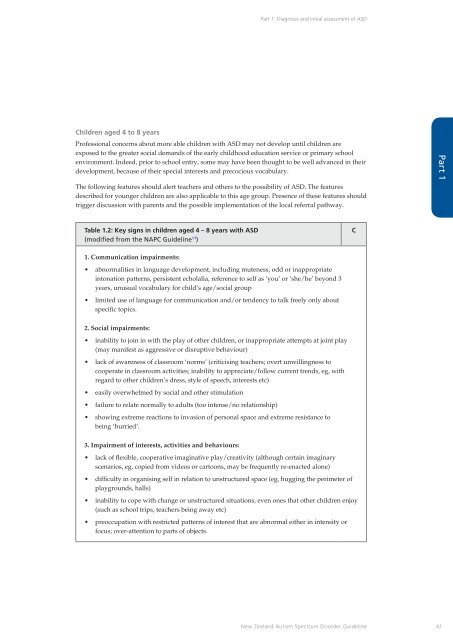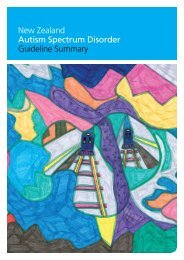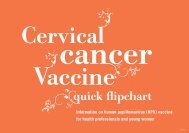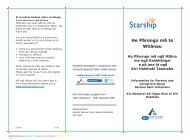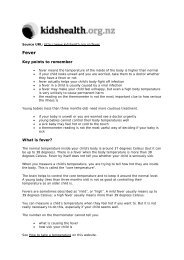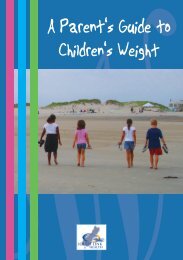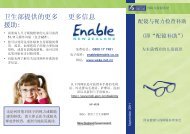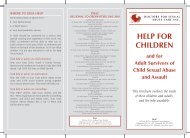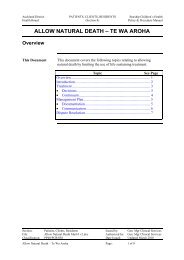New Zealand Autism Spectrum Disorder Guideline - Ministry of Health
New Zealand Autism Spectrum Disorder Guideline - Ministry of Health
New Zealand Autism Spectrum Disorder Guideline - Ministry of Health
You also want an ePaper? Increase the reach of your titles
YUMPU automatically turns print PDFs into web optimized ePapers that Google loves.
Part 1: Diagnosis and initial assessment <strong>of</strong> ASD<br />
Children aged 4 to 8 years<br />
Pr<strong>of</strong>essional concerns about more able children with ASD may not develop until children are<br />
exposed to the greater social demands <strong>of</strong> the early childhood education service or primary school<br />
environment. Indeed, prior to school entry, some may have been thought to be well advanced in their<br />
development, because <strong>of</strong> their special interests and precocious vocabulary.<br />
The following features should alert teachers and others to the possibility <strong>of</strong> ASD. The features<br />
described for younger children are also applicable to this age group. Presence <strong>of</strong> these features should<br />
trigger discussion with parents and the possible implementation <strong>of</strong> the local referral pathway.<br />
Part 1<br />
Table 1.2: Key signs in children aged 4 – 8 years with ASD<br />
(modified from the NAPC <strong>Guideline</strong> 11 )<br />
C<br />
1. Communication impairments:<br />
• abnormalities in language development, including muteness, odd or inappropriate<br />
intonation patterns, persistent echolalia, reference to self as ‘you’ or ‘she/he’ beyond 3<br />
years, unusual vocabulary for child’s age/social group<br />
• limited use <strong>of</strong> language for communication and/or tendency to talk freely only about<br />
specific topics.<br />
2. Social impairments:<br />
• inability to join in with the play <strong>of</strong> other children, or inappropriate attempts at joint play<br />
(may manifest as aggressive or disruptive behaviour)<br />
• lack <strong>of</strong> awareness <strong>of</strong> classroom ‘norms’ (criticising teachers; overt unwillingness to<br />
cooperate in classroom activities; inability to appreciate/follow current trends, eg, with<br />
regard to other children’s dress, style <strong>of</strong> speech, interests etc)<br />
• easily overwhelmed by social and other stimulation<br />
• failure to relate normally to adults (too intense/no relationship)<br />
• showing extreme reactions to invasion <strong>of</strong> personal space and extreme resistance to<br />
being ‘hurried’.<br />
3. Impairment <strong>of</strong> interests, activities and behaviours:<br />
• lack <strong>of</strong> flexible, cooperative imaginative play/creativity (although certain imaginary<br />
scenarios, eg, copied from videos or cartoons, may be frequently re-enacted alone)<br />
• difficulty in organising self in relation to unstructured space (eg, hugging the perimeter <strong>of</strong><br />
playgrounds, halls)<br />
• inability to cope with change or unstructured situations, even ones that other children enjoy<br />
(such as school trips, teachers being away etc)<br />
• preoccupation with restricted patterns <strong>of</strong> interest that are abnormal either in intensity or<br />
focus; over-attention to parts <strong>of</strong> objects.<br />
<strong>New</strong> <strong>Zealand</strong> <strong>Autism</strong> <strong>Spectrum</strong> <strong>Disorder</strong> <strong>Guideline</strong> 41


